| | Games Around New England |
| | David Harris |
| | November 2011 |
| | Larry Dean 2001
David Harris 2081
Sven Brask Summer Swiss 2011
[C61] Ruy Lopez
Playing to win for Black requires taking risks. Luckily, enterprising play is always welcome at the Sven Brask! 1.e4 e5 2.Nf3 Nc6 3.Bb5 Nd4 4.Nxd4 exd4 5.0-0 h5 6.d3 Ne7 7.Bg5 f6 8.Bd2 a6 9.Bc4 d5 10.exd5 Qd6 11.Qf3 Bg4 12.Qf4 Qd7 13.h3 0-0-0 14.hxg4 hxg4 15.Re1 Ng6 16.Qxd4 Qf5 17.Qe4 Qh5 18.Kf1 Bd6
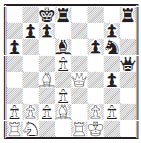
19.Be3 [Or the amusing 19.Qd4 Nh4 20.Re6 Nf3! 21.Qa7 Qh1+ 22.Ke2 Qxg2 23.Be1 Qf1+!!] 19...f5 20.Qd4 f4 21.Qa7 f3 0-1
David Harris 2106
IM Jonathan Yedidia 2416
New England Open 2011 (1)
[C30] King’s Gambit Declined
The King’s Gambit is not often seen these days. Delaying f4 until after Nc3 or Bc4 avoids the Falkbeer Countergambit (2... d5), and encourages the King’s Gambit Declined. Move order nuances like this reduce the amount of time we need to spend on opening preparation, with without resorting to 1.g3. 1.e4 e5 2.Bc4 Nc6 3.f4 Bc5 4.Nf3 d6 5.Nc3 a6 6.d3 Nf6 7.f5 h6 8.Qe2 Na5 9.Bb3 Nxb3 10.axb3 0-0
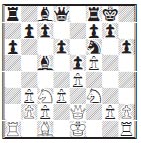
11.g4! Nxg4 12.Qg2 Ne3 [The alternative is nothing to write home about: 12...h5 13.h3 Nf6 14.Bh6 Ne8 15.0-0-0] 13.Bxe3 Bxe3 14.Nd5 Bg5 [14...Ba7 Before playing 11.g4 I had analyzed this position and found the following winning line: 15.f6 g6 16.Ne7+ Kh7 17.Ng5+ hxg5 (17...Kh8 18.h4) 18.Qxg5; A similar fate awaits 14...Bc5 15.f6 g6 16.Ne7+ Kh7 17.Ng5+ Kh8 18.Qd2! Qe8 19.h4 Bg4 20.h5 Bxh5 21.Ne6] 15.Nxg5 Qxg5 16.Qxg5 hxg5 17.Nxc7 [Yedidia was more worried about 17.h4 g4 18.Nxc7] 17...Rb8 18.Nd5 f6 19.Nb6 Kf7 20.Ra4 g6 Black must free his position at all costs. White’s task is to keep the position clamped down, so the pawn on f5 needs to be nailed to the board. 21.Rf1 gxf5 22.exf5 Rh8 23.Rc4 Ke7 24.Nd5+ Kd8 25.Nxf6 Bd7 26.Rg4 Rxh2 27.Rxg5 Rc8 28.c4 Rxb2 29.Nd5! Ke8 [At first glance, it appears the Black can be rescued by 29...Rb1+ 30.Ke2! Rxf1 31.Rg8+! Be8 32.Kxf1+- with f6 to follow] 30.Rf3 Rh2 31.Rg7 e4 32.dxe4 Rc5 33.Nf6+ Kd8 34.Rxd7+ Kc8 35.Rg3 Kb8 36.Rg8+ Ka7 37.Rdd8 Re5 38.Ra8+ Kb6 39.b4 Kc7 40.Rgc8+ Kb6 41.Nd7# 1-0
Andrew Wang 2237
David Harris 2106
New England Open 2011 (2)
[B21] Sicilian Defense
While the move Bb5 is unlikely to put the Sicilian out of business, an understanding of the Anti-Sicilian systems is just as important as knowing the main lines of the Open Sicilian. In the Moscow Variation, I have an aversion to playing an early e5, but current opening theory does support giving White the d5 hole in exchange for the two bishops. 1.e4 c5 2.Nf3 d6 3.Bb5+ Nd7 4.d4 Ngf6 5.Nc3 cxd4 6.Qxd4 e6 Cleverly avoiding e5! 7.Bg5 h6 8.Bh4 a6 9.Bxd7+ Bxd7 10.0-0-0 Rc8 [10... e5! 11.Bxf6 exd4 12.Bxd8 dxc3 13.Bc7 White has a small edge] 11.Rhe1 [11.e5! g5 12.Bg3 dxe5 13.Bxe5 Bc5 14.Qd3 Be7 15.Ne4 Nxe4 16.Qxe4 0-0 17.h4+/- White has a strong attack] 11...e5 12.Qd3 g5 13.Bg3 Be7 14.Nd2 We finally arrive at the tabiya for this variation, with a subtle difference, Black expended 2 moves on e5. The lost tempo is O-O which is acceptable, as the king is safer in the center, given the holes in the black kingside. 14...Qc7 Inaccurate perhaps, but Black must not allow Nc4. 15.Nf1! Be6 16.Ne3 Qa5 (D)
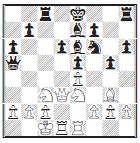
17.Kb1?! [17.Nf5! A knight must answer the call to action! 17...Bxf5 18.exf5 b5 with advantage to White] 17...Rxc3! 18.bxc3 Qxa2+ A thematic sacrifi ce, and a bonus point! 19.Kc1 0-0 20.Kd2 Qa4 21.f3 Qc6 22.c4 Rc8 23.Nd5 Bd8 24.Ra1 Qxc4 25.Qxc4 Rxc4 26.Nxf6+ Bxf6 27.Reb1 Rc7 28.Rb6 Be7 29.Rab1 Bc8
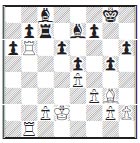
The dust has settled and the position is roughly level. Black’s two bishops are not a factor with the Black army in such disarray. 30.Kd3 f5 31.Be1 Kf7 32.Ba5 fxe4+!? [32...d5!?] 33.fxe4 Rd7 [33...d5!] 34.R6b3 d5? [34...b5!] 35.Rc3! dxe4+ 36.Ke3! b6 37.Rxc8 bxa5 38.Rc6 White has eliminated the bishop pair and shattered Black’s pawn structure. But the worst is yet to come. 38...Bb4 39.Kxe4 Rd2 40.c3 Bd6 41.Rb7+ Ke6 42.c4 Eliminating the other half of the bishop pair 42...Rd4+ 43.Ke3 a4 44.c5 a3 45.cxd6 a2 46.d7+ Kf5 47.Rxa6 Re4+ 48.Kd3 Rd4+ 49.Kc3 Rd6 50.Rxa2 1-0
Joshua Quint 1989
David Harris 2129
Bedford Rating Round Robin
2011, Bedford, NH (4)
[D94] Gruenfeld Defense
1.d4 Nf6 2.c4 g6 3.Nc3 d5 4.Nf3 Bg7 5.e3 0-0 6.a3 a5 7.b3 c5 8.Bb2 cxd4 9.exd4 Bg4 10.Be2 dxc4 11.bxc4 Nc6 12.d5 Bxf3 13.Bxf3 Ne5 14.Be2 Rc8 15.Qb3 Nfd7 16.Na4 Qc7 17.Rc1
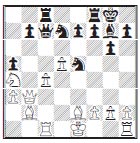
b5 18.cxb5 Qxc1+ 19.Bxc1 Rxc1+ 20.Bd1 Nc4 21.0-0 Rc8 22.Qd3 Ra1 23.Qh3 f5 24.Qd3 Rxa3 25.Qe2 Nde5 26.f4 Re3 27.Qa2 Nd3 28.h3 Bd4 29.Kh2 Nb4 30.Qf2 Nxd5 31.Bf3 Nxf4 32.Re1 e5 33.Rxe3 Bxe3 34.Qa2 Kg7 35.Bc6 Nd2 36.Nc3 Nf1+ 37.Kh1 Ng3+ 38.Kh2 Nf1+ 39.Kh1 Nd3 40.Nd1 Ng3+ 41.Kh2 1/2-1/2
Robert Cousins 2194
David Harris 2129
Bedford Rating Round Robin
2011, Bedford, NH (6)
[E32] Nimzo-Indian Defense
There is a fi ne line between a calculated risk, and folly. Miscalculation is the mother of invention. 1.c4 e6 2.d4 Nf6 3.Nc3 Bb4 4.Qc2 0-0 5.a3 Bxc3+ 6.Qxc3 b5 7.Qf3 [The main line of this interesting gambit runs 7.cxb5 c6 8.bxc6 Nxc6 9.b4] 7...d5 8.cxb5 a6 9.bxa6 c5 10.dxc5 Nxa6 11.Rb1 Ne4!? 12.b4 Naxc5 13.bxc5 Qa5+ 14.Rb4
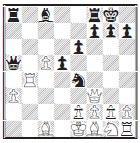
Black has donated a full bishop to the cause. White has a completely undeveloped kingside, the queen’s rook is pinned, and the queen is awkwardly placed. I am happy to get positions like this when I am playing for a win with Black. 14...Ba6 15.Qe3 Rac8 16.f3 Nxc5 17.Bd2 Qc7 [Another try is 17...e5 18.Rb8 (18.Qxe5!? Nd3+ 19.exd3 Rfe8 with compensation) 18...Qc7 19.Rxc8 Rxc8 20.Qc3 d4 21.Qa5 Qxa5 22.Bxa5 e4 (D)
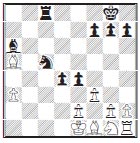
would be an odd turn of events, White has traded queens, and has an extra bishop. Yet Black is winning.] 18.Bc3? [White seems to have decent prospects after 18.Qd4 Rfe8 19.Qb2 e5 20.Nh3] 18...Nd3+ 19.exd3 Qxc3+ 20.Qd2 Qxa3 21.Qb2 Rc1+ 22.Kf2 Rxf1+ [22...Rc2+ 23.Qxc2 Qxb4 24.g3 Rc8 25.Qa2 Qd4+ 26.Kg2 Bxd3 27.Bxd3 Qxd3 28.Ne2 g5] 23.Kxf1 Qxd3+ 24.Kf2 Qf1+ 25.Kg3 Qe1+ 26.Kh3 e5 Black now has two pawns for a rook. White has neither developed the kingside, nor found safe harbor for the monarch. 27.Qb1 Bc8+ 28.g4 Qe3 29.Kg2 Qd2+ 30.Kg3 f5 31.gxf5 Bxf5 [31...Rxf5 In light of the defensive resource at move 34, this must be the correct recapture. In murky positions like this it is never clear which path to take, which is what makes them so interesting! 32.h4 Rf6 33.Rb8 Rg6+ 34.Qxg6 Qf4+ 35.Kf2 Qd4+ 36.Ke2 hxg6 37.Rxc8+ Kf7 38.Nh3 Qxh4=] 32.Qb2 Qg5+ 33.Kf2 d4 34.Qb3+ [34.h4! Appears to save the day 34...Qe3+ 35.Kg2. The compensation is rather sketchy] 34...Kh8 35.h4 Qd2+ 36.Ne2? [Correct play now leads to a draw 36.Kg3 Qe1+ 37.Kg2 Qd2+ 38.Kg3 Qf4+ 39.Kf2 Qd2+] 36...Bd3 37.Rb8 Qxe2+ 38.Kg3 Qxf3+ 39.Kh2 Qf2+ 40.Kh3 Bf5# 0-1
David Harris 2134
Paul Gavlick 1600
Max Malyuta Memorial 2011 (2)
[C26] Vienna Game
The battle of nerves is just as important as the battle on the board. Once outplayed, it is diffi cult to regain your composure. 1.e4 e5 2.Nc3 Nf6 3.d3 Perhaps not one of the top ten moves 3...Be7 [3...d5 is critical] 4.f4 d6 5.Nf3 Nc6 6.f5?! [Logic dictates 6.Be2 ] 6...Nd4!? 7.Be3 c5! Anchoring the annoying knight 8.Ne2 Nxf3+ 9.gxf3 Nh5 [Another strong idea is 9...g6 ] 10.c3 Bh4+ 11.Kd2 Bg5 12.Bxg5 Qxg5+=/+ 13.Kc2 Lackluster opening play by White has left him with an awkward position 13...Qe3 14.Bg2 b5 15.Qd2 Qxd2+ 16.Kxd2 Bb7 17.Rhg1 a5! 18.Raf1 b4 19.f4! Nf6! Although roughly level, Black has clearly won the psychological battle. Now White will begin a downward spiral. 20.d4!? exd4 21.e5 Bxg2! 22.Rxg2 dxe5 23.fxe5 dxc3+ 24.bxc3 Rd8+ 25.Kc1 Nh5 26.Rg5 g6 27.e6 f6! 28.Rg4 g5 29.h4 h6 30.hxg5 hxg5 31.Rh1?! Ke7!
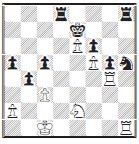
32.Rc4? Right square, wrong time! 32...Nf4! 33.Re1? [33.Ng3 Ne2+! 34.Kc2 Rxh1 35.Nxh1 Rd5 wins f5, e6 and the game] 33...Nd3+ 34.Kd2 Ne5+! 35.Rd4 cxd4 36.cxd4 Nf3+ Enough already! 0-1
Miro Reverby 2230
Denys Shmelov 2519
Max Malyuta Memorial 2011 (2)
[B20] Sicilian Defense
This pivotal battle in the Malyuta Memorial illustrates the importance of timing. A zwischenzug on move 23 would have saved the day. 1.e4 e6 2.d3 c5 3.g3 Nc6 4.Bg2 g6 5.Ne2 Bg7 6.c3 Nge7 7.Be3 b6 8.Qd2 Ba6 9.Na3 d5 10.Rd1 0-0 11.Bh6 Qd7 12.Bxg7 Kxg7 13.f4 f6 14.0-0 Rad8 15.Qc2 e5 16.Qa4 Bb7 17.b4?! cxb4 18.cxb4 a5 [Now is the time for 18...Nd4! 19.Qxd7 Nxe2+ 20.Kf2 Rxd7 21.Kxe2 Nc6=/+ Black has an edge in a less complicated position] 19.bxa5 Nd4 20.Qxd7 Nxe2+ 21.Kf2 Rxd7 22.Kxe2 exf4
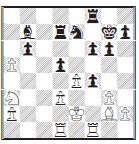
23.gxf4 [23.Bh3 leads to complications with chances for both sides 23...Rdd8 (less clear is 23...Rc7 24.axb6 Rc6 25.exd5 Nxd5 26.Nc4 Nc3+ 27.Kf2 Nxd1+ 28.Rxd1 fxg3+ 29.hxg3 Ra8 30.a3 with compensation for the exchange) 24.Rc1 Ba6 25.Rc7 dxe4 26.Rxe7+ Kh6 (26...Rf7 is necessary) 27.Rxf4 a resource missing in the line 24 Bh3, which turns the tables] 23...Ra8 24.Rb1!? [24.Bh3 now requires precise play by Black 24...Rdd8 25.Rc1 activating the rook(s) is the key 25...dxe4 (or 25...Rxa5 26.Rc7 Kf8 the king must step out of the pin in view of the idea Rf1-c1-c7 27.e5 f5 28.Rxb7 Rxa3 with complications favoring Black) 26.Rc7 Ba6 27.Rxe7+ Kh6! Note how the pawn on f4 gives Black a much better version of the analogous 23 Bh3! line] 24...Rxa5 Black has a comfortable advantage 25.Rb3 dxe4 26.Bxe4 Bd5 27.Bxd5 Nxd5 28.Kf3 Ra4 [Or the direct hit 28...Nxf4! ] 29.Kg3 h5 30.Rf2 Time pressure begins to take its toll 30...Ne3 [30...h4+!] 31.Re2? Nf5+ 32.Kg2 Nd4 33.Re4 f5 Winning an exchange and a pawn. 0-1
Denys Shmelov 2519
Robert Perez 2418
Max Malyuta Memorial 2011 (3)
[E25] Nimzo-Indian Defense
1.d4 Nf6 2.c4 e6 3.Nc3 Bb4 4.f3 d5 5.a3 Bxc3+ 6.bxc3 c5 7.cxd5 exd5 8.e3 0-0 9.Bd3 b6 10.Ne2 Ba6 11.Bxa6 Nxa6 12.Qd3 c4 13.Qc2 Re8 14.0-0 h5 15.Ng3 Re6 16.Bd2 Qd7 17.Nh1 Rae8 18.Nf2 Nc7 19.a4 Qc6 20.Rae1 b5 21.axb5 Nxb5 22.Re2 a5 23.Rfe1 Nd6

24.Bc1 g6 25.Ba3 Nb5 26.Bc1 Nd6 27.Kh1 Kg7 28.Kg1 1/2-1/2
Sinclair Banks 2234
Miro Reverby 2242
Blackstone Anniversary Vamp
2011 (2)
[D07] Chigorin Defense
The pivotal game from the annual Vamp at the Blackstone Chess Center. Reverby pulled the Chigorin Defence out of his toolbox. Banks reinforced the center and built a wall of pawns on the dark squares. 1.d4 d5 2.c4 Nc6 3.cxd5 Qxd5 4.e3 e5 5.Nc3 Bb4 6.Bd2 Bxc3 7.bxc3 Qd6 8.f4 e4 9.Ne2 Qg6 10.Rb1 Nf6 11.c4 0-0 12.g3 h5 13.Bg2 h4 14.Rb5 h3 15.Bf1 Bg4 16.Rxb7 Rab8 17.Qb3 Bf3 18.Rg1 Ng4 19.d5 Rxb7 20.Qxb7 Ne7 21.Nd4 Nxh2 22.Bxh3 Qh5 23.Bb4 Qxh3 24.Bxe7 Ng4 25.Qb2 Re8 26.Nf5 Qh7 27.Qb5 Qh2
The mate in 1 is obvious, but can you fi nd the mate in 13? A suitable fi nish for a game played on November 13th. 28.c5 Qf2# 0-1
|